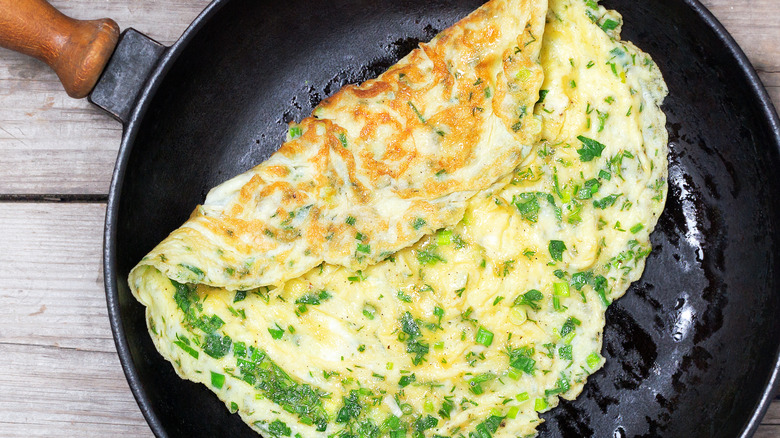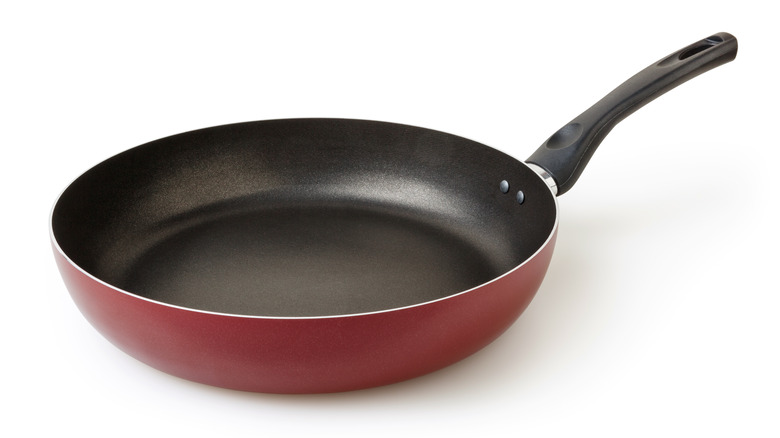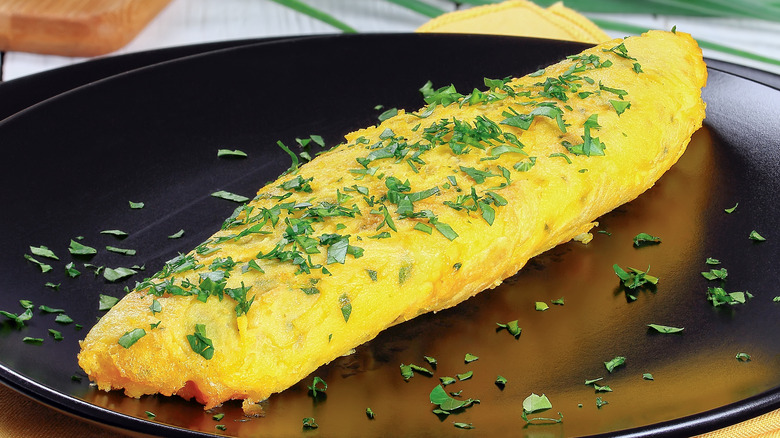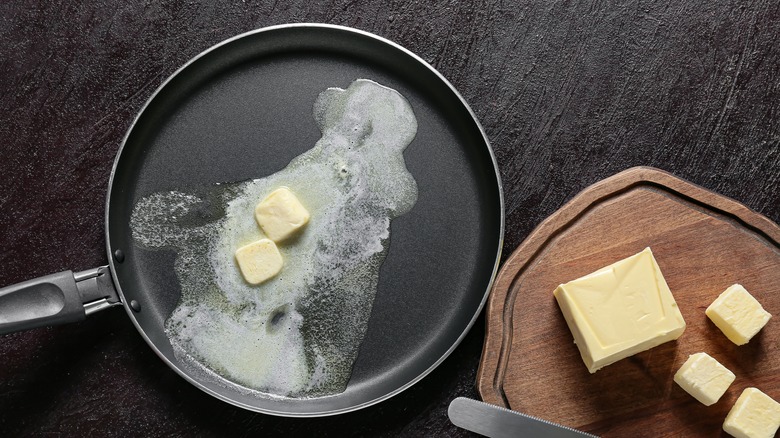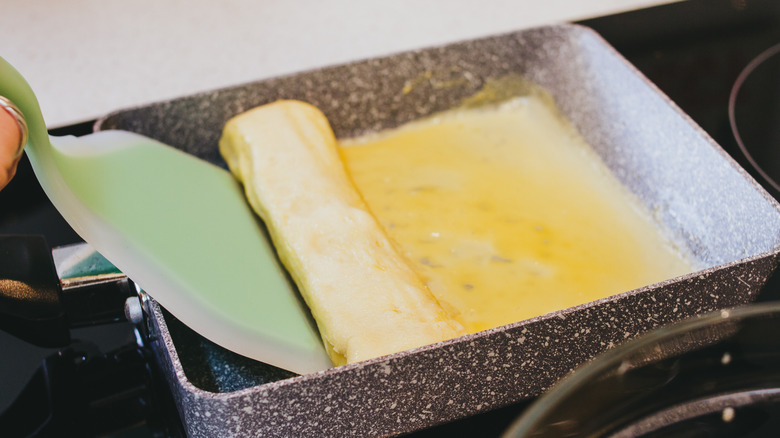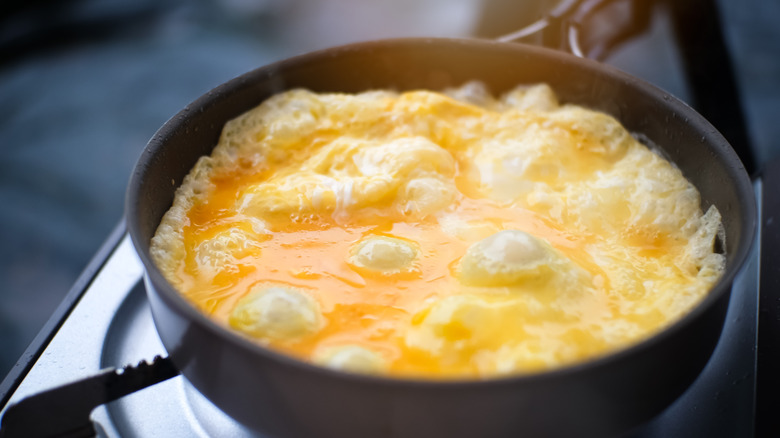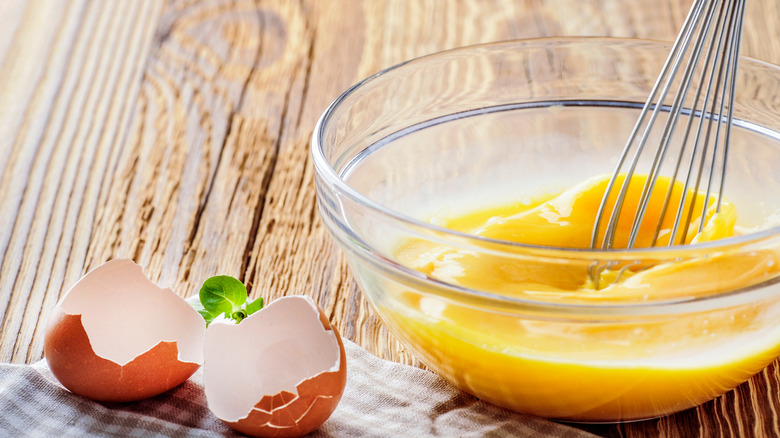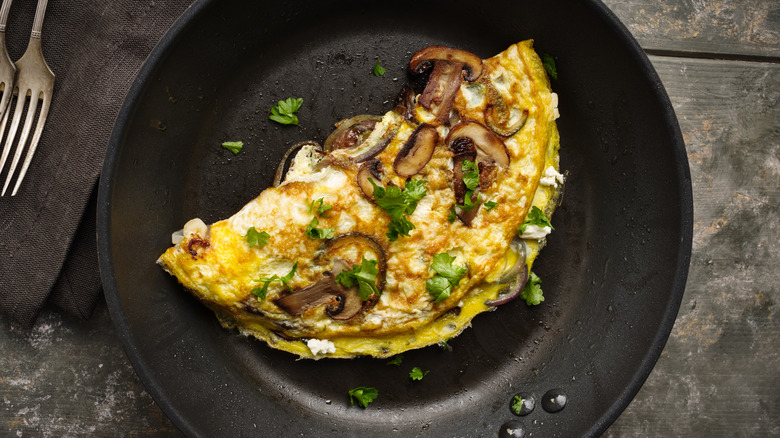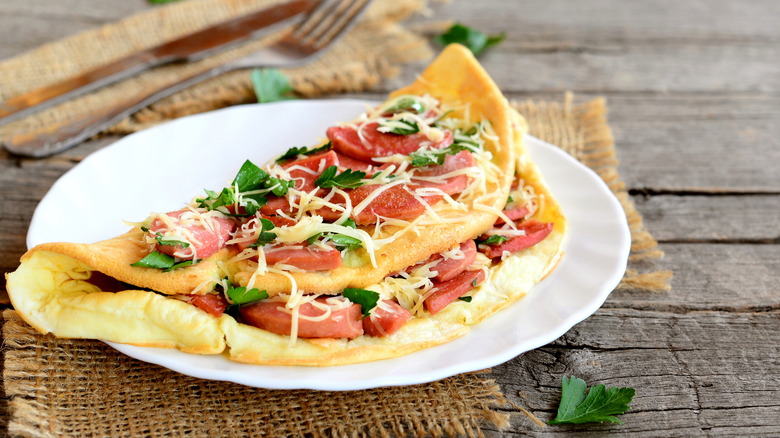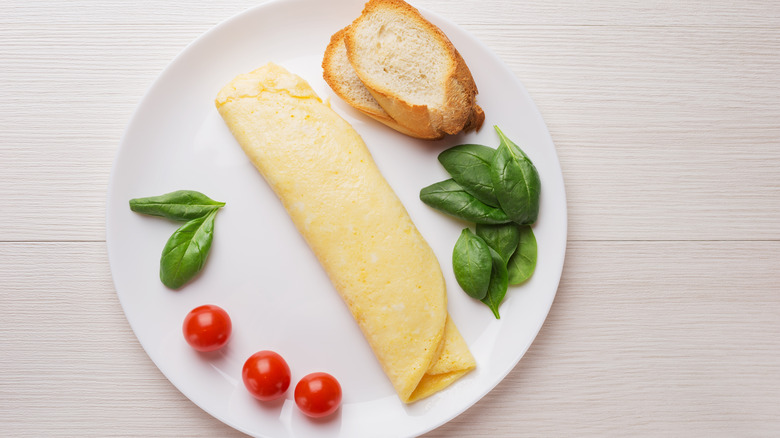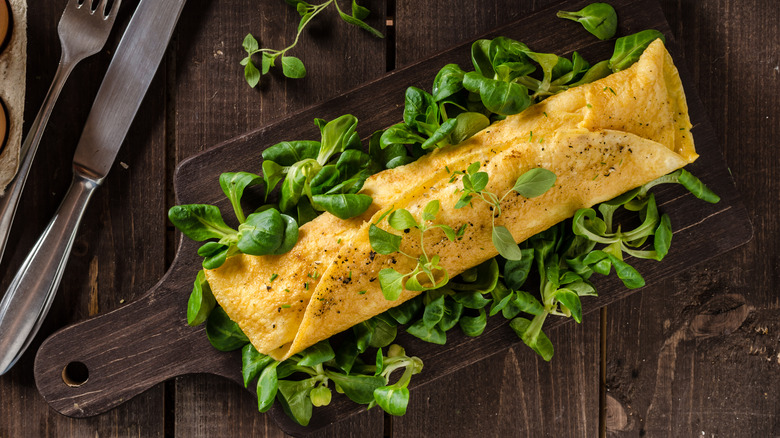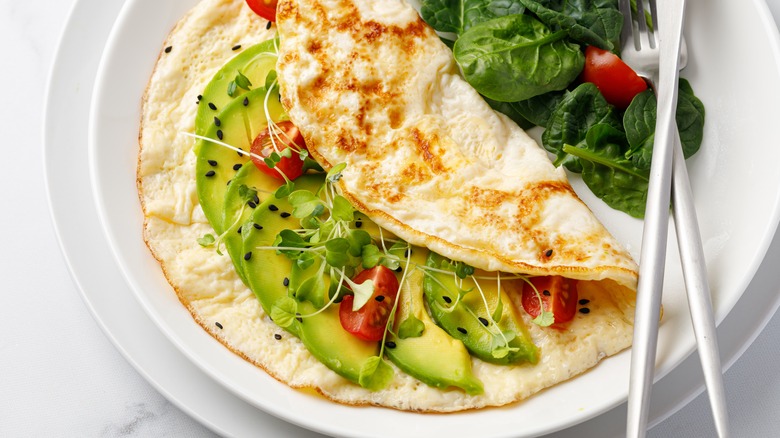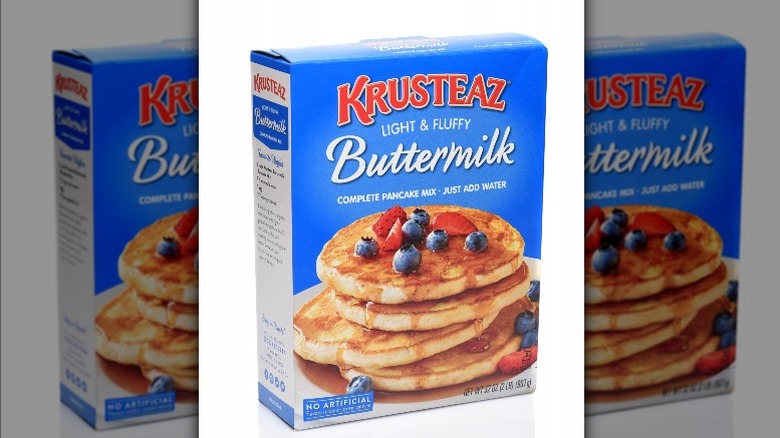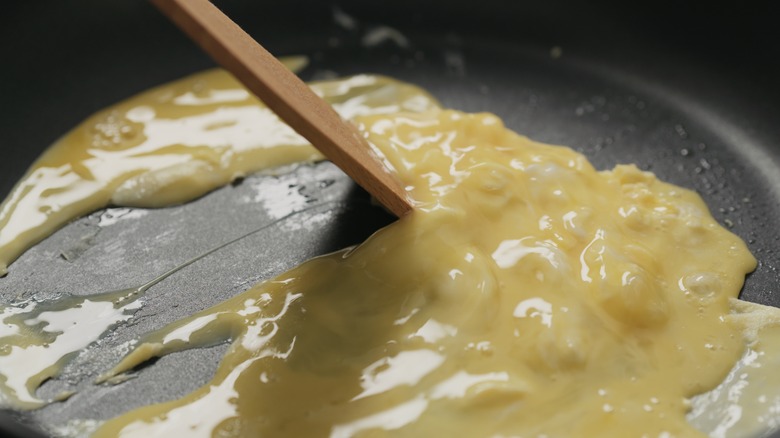13 Tips For Making The Absolute Best Omelets
There's nothing quite as satisfying as making a perfectly cooked, beautiful-looking omelet. Sadly, it's a tough trick to pull off. There's a reason Wolfgang Puck tests chefs who want to work for him by asking them to cook an omelet — the folded egg pancake is a challenging dish that showcases good technique and punishes even minor mistakes (via YouTube).
There are no shortcuts to becoming an omelet master. If you want proficiency, you'll have to earn it with practice and repetition. However, there are pro moves that will help you cook your omelets the right way. If you're tired of turning out plates of substandard eggs, we're here to help. This collection of omelet tips will help you bring your omelet game to the next level. We can't guarantee your omelets will be up to Wolfgang Puck's exacting standards, but at least they'll make you and your family happy. So whether you like creamy French omelets or hearty country-style ones stuffed to the brim with fillings, here are our essential omelet secrets.
Choose your pan carefully
You can have all of your omelet techniques down perfectly, but nothing will save you if you don't have the right pan. If your eggs stick to your pan, then you'll have to content yourself with eating scrambled eggs instead of a beautifully-folded omelet for breakfast.
For the easiest cooking, nonstick is a safe bet. You might want to choose nonstick if you're not a very experienced omelet chef. If you don't go with nonstick, then you still want to find a pan made of a material that you can season to make it partially stick-resistant such as cast iron, carbon steel, or aluminum. If you go this route, heat the pan with some oil in it and let it sit for a while in order to season it before you use it for the first time.
The shape is also important to consider. You want a pan without sharp corners (unless you're choosing a square tamagoyaki pan for Japanese rolled omelets). For Western-style omelets, something with gently sloped sides is best. A moderately high edge will help with turning your omelet over, and a heavy bottom will ensure even heat distribution. Finally, choose the size that fits your lifestyle: An 8-inch pan is perfect for solo cooks, but if you're cooking for a family you might want a 10 or even 12-inch omelet pan.
Add water for extra-fluffy eggs
This secret isn't for everyone — it depends on how you like your omelets. If you want your eggs to be as fluffy as possible, mix a little water with them while you're beating them. Culinary journalist Steven A. Shaw endorsed the water trick, recommending a ratio of a teaspoon of water for every egg. He speculated that the water in the beaten egg mixture evaporates as the omelet cooks, leaving behind tiny bubbles that lighten the texture of the finished product (via eGullet).
However, you may find that the water also dilutes the rich taste of the eggs. A writer for The Guardian tested out Shaw's water trick and didn't like what it did to their omelets. The water did indeed make the omelet fluffier, but the writer preferred the intense flavor of an eggs-only omelet with no extra liquid mixed in. It's a matter of taste, so you might want to experiment with different recipes yourself at home.
No matter whether you add water to your eggs or not, you should definitely season them with salt and pepper before cooking. Salting eggs before cooking not only adds flavor but can actually make your eggs softer and more tender.
Pay attention to your butter
Of course, for pure utility, you could use any type of fat you wanted to cook your omelet. As long as it prevents the eggs from sticking to your pan, you are free to choose the fat that you like best. However, butter is the classic choice, and it's not just because French chefs put butter in everything.
Butter is delicious, so that's an obvious benefit. There's nothing quite like the rich, slightly nutty flavor of good butter when paired with creamy eggs. But besides the flavor, butter has another advantage over other fats for omelet cookery: It's effectively a built-in thermometer that lets you know when your pan is the perfect temperature for adding your eggs.
When you warm butter in a skillet, it will initially start to bubble up and make crackling sounds. For a classic French-style omelet with a runny center and a pale golden exterior, the pan is the right temperature once the bubbling subsides (via The Guardian). If you overshoot this mark, your butter will begin to brown. You can still cook tasty eggs at this point, but rather than a perfect French omelet, you'll be making a more rustic variety with a slightly browned exterior.
Different omelets require different techniques
As Jacques Pépin so astutely observes, there is no one perfect omelet: "A classic French omelet as I do is not better than the country one, it's just different in technique, in texture, and in taste a little bit, so you choose one or the other." You need to be sure of what kind of omelet you want to make before figuring out which techniques to use. Do you want a country omelet with big curds and a slightly crisp, browned exterior, or are you chasing the dream of an Instagram-perfect, cylindrical French specimen? There's no point in mastering the difficult French technique if you don't even like runny eggs. The various omelet styles are completely different dishes, and as such, there's not a lot of overlap in how they're prepared.
That's particularly true once you expand beyond Western culinary traditions. Japanese omelets, known as tamagoyaki, require a very different set of skills than the omelets from your average hotel buffet. You need a special square pan, and the eggs are pre-seasoned with Japanese ingredients like mirin and dashi. Most interestingly, instead of cooking the omelet all at once, you build it slowly by pouring thin sheets of egg into the pan over and over again, rolling each new layer around the previous ones once it's cooked.
Shake the pan
It's natural when you're cooking to want to manipulate the food with an implement of some sort. For an omelet, most people would reach for some kind of heat-proof rubber spatula. While a spatula will certainly give you a helping hand, when making omelets, you can invert your usual thinking: Instead of moving the spatula, move the pan.
Shaking the eggs around the pan helps to evenly distribute the uncooked eggs throughout the skillet. If you're a true omelet master, you can even ditch the spatula entirely. Julia Child memorably demonstrates this in the omelet episode of her show "The French Chef." Before the opening credits roll, she cooks and plates a perfect omelet in 30 seconds using one hand and zero spatulas.
For those of us who can't leave utensils behind completely, Child does demonstrate a slightly easier method later on in the episode where she stirs the eggs with a fork while shaking the pan. Just note that if you're using a nonstick skillet, you should use some kind of heatproof plastic, silicone, or rubber utensil instead of a metal fork. Never use metal utensils with nonstick pans, as the metal will scratch the coating. Not only will this ruin the pan, but it might also lead to you eating Teflon — yuck.
Beat your eggs thoroughly
Unless you're making a soufflé omelet, you're not whipping eggs to stiff peaks for your breakfast meal. It can be tempting to take things to the opposite extreme and just barely beat the eggs before adding them to the pan. While it might not seem like a big deal, your omelets will come out better if you thoroughly whip the eggs.
There are two distinct reasons for this. The first is mostly aesthetic: If you under-beat your eggs, you'll have streaks of unmixed white and yolk running through your omelet. That might not bother you, but if you're trying to make a beautiful French omelet with finesse, visual imperfections can ruin the experience.
The second reason to not skimp on whisking has to do with the omelet's texture. If you prefer the intense flavor of an eggs-only omelet without milk or water added to it but still desire a fluffy texture, the solution is to thoroughly whip the eggs to incorporate air into them. You're looking for the color of your egg mixture to lighten — once you've achieved this, you can stop beating.
Wait until your eggs are almost cooked to fold
The last-minute fold might be the most perilous part of the omelet preparation process. If you're too quick on the trigger, the delicate eggs might all break apart. That's not the end of the world — you can just tell your family you were intending on cooking a loaded scramble the whole time and nobody will be the wiser. The opposite mistake is much worse. If you wait too long, your eggs will be extra-crispy and brown (or even burnt) on the outside, and they might be rubbery inside as well. A little bit of browning on the exterior of an omelet can be tasty, but nobody likes super-overcooked eggs.
When cooking an omelet, you want to be agitating the eggs the whole time. You're basically making scrambled eggs. You'll know it's time to fold your omelet once your eggs are mostly set, just before you'd stop cooking them if you were making scrambled eggs. Let the last bit of raw egg make a little shell for the scrambled curds, then fold with confidence.
Pre-cook your fillings
We can all envy the professional omelet cook who has convenient trays of pre-prepped ingredients at their disposal, ready to throw into an omelet at a moment's notice. But if you're cooking at home, is it fine to just skip the prep and throw your omelet fillings in raw? We'd love to tell you that you could take advantage of this easy hack, but we can't recommend adding raw ingredients to an omelet.
The reason you shouldn't fill your omelet with raw ingredients is that omelets cook fast — like really fast. Remember when Julia Child cooked an omelet in approximately 30 seconds? There aren't many omelet toppings that cook in such a short time. Unless you enjoy eggs filled with crunchy raw onions and cold ham, you're going to need to pre-cook most omelet fillings. Even cold cheese might not melt completely by the time the eggs are cooked, so if you want that perfect ooey-gooey cheese pull, consider starting with room temperature or slightly-warmed cheese.
Don't overcook your eggs
We know we said that there's room for personal preference in terms of how cooked you like your eggs, but there's an upper limit to that. There are few foods less appetizing than tough, overcooked eggs. It's very important to avoid overcooking if you're trying to crack the formula for a classic French omelet.
For this style of omelet, the Platonic ideal you're seeking to achieve is a thin sheath of cooked egg enrobing an interior of creamy, soft scrambled eggs. In order to achieve this goal, you need to stop cooking the omelet a little bit before it actually looks done. The eggs should be mostly set, but with a tiny little bit of runniness left. The residual heat from the pan will cook the eggs the rest of the way. Finishing the omelet gently like this will ensure that you get that amazing yellow exterior without a hint of browning that is characteristic of this preparation.
Don't forget to stick the landing
Once your eggs are perfectly cooked, you now have to complete a perilous step: Getting the cooked eggs out of the pan and onto a plate without turning them into a Jackson Pollock-esque splatter. This isn't as much of a problem with country or American-style omelets that have a little more structural integrity, but French omelets are more challenging to de-pan. Not only are the eggs in a French omelet somewhat soft and runny, but you're also trying to make a neatly-rolled oval or cylinder on the plate.
As with so much French culinary knowledge, Julia Child is a good resource for this technique. In her omelet episode, she demonstrates that once the eggs are mostly cooked, you need to angle your pan and knock or push the curds into a mass right at the edge of the skillet. Then you pick up your plate and invert the omelet onto it, using the lip of the pan to roll it into shape. Jacques Pépin shows how you can switch your grip on the skillet to make the pan flip a little bit easier (via YouTube). We're not going to lie to you: This maneuver is going to take some practice to get right. However, the good news is that if your omelet belly-flops onto the plate, you can use your hands to push it into shape before serving it.
You can make an egg white or egg yolk omelet, but that changes the technique
Almost all of the tips in this article are for omelets made with whole eggs, but of course, you can make omelets with separated eggs as well. Egg white omelets are a common choice for health-conscious diners since egg whites are low in fat and cholesterol but very high in protein. However, they're also bland, and they don't hold together in the pan as well as whole eggs. You're going to want to add a lot of seasonings and healthy toppings in order to inject some flavor into your egg whites. To solve egg whites' structural integrity problems, wait until the whites are completely set and cooked through before attempting to flip them out of the pan. You're not going to get luscious, creamy curds with this type of omelet.
On the other end of the spectrum is the egg yolk omelet made famous (or perhaps infamous) by James Corden's wife, Julia Carey. The problem with this unorthodox omelet order, as pointed out by The Washington Post, is that pure egg yolks have a dense texture with none of the fluff of a classic omelet. The solution to this issue, per People, is to add a significant amount of water to the yolks when you beat them: one tablespoon for every two egg yolks.
Pancake mix adds structural integrity
This tip only applies if you like a certain type of omelet — specifically, the sturdy-yet-fluffy, slightly browned diner-style omelets served at IHOP. The secret to IHOP's unique omelets is that a small amount of pancake mix is added to the eggs.
The pancake mix changes the texture of the omelet. You might find that it makes your omelets fluffier, or you might describe the texture as springy, as a Lifehacker writer who tried this trick did. The pancake mix makes the egg mixture sturdier, so it's a little bit easier to manipulate in the pan. It also subtly alters the flavor of the eggs, lending a bit of mild sweetness and toastiness to the omelet.
To try this out, simply add a small amount of dry boxed pancake mix to your eggs and whisk until you can't see any lumps. We feel like this technique would be weird if you applied it to a classic French omelet instead of a diner-style one, but if any brave kitchen scientists want to run that experiment, let us know how it goes.
Stir in circles for even cooking
If you're struggling with the pan-shaking method or just want to try another way of preparing omelets, keep in mind that there are multiple correct ways of preparing the egg dish. It turns out that circles are key to a more advanced omelet cooking technique. Instead of moving the pan, stir the eggs in a circle when making omelets. You start small, then move your spatula in larger circles as the eggs begin to firm up. Once the eggs are mostly done, tap the skillet on the surface of the stove. This sets the eggs down in the pan, making sure the exterior of your omelet will be even and smooth once it comes out of the skillet.
If you want to make sure the outside of your omelet looks extra smooth and glossy, paint it with some butter while it's still hot. This will help you get the professional-looking omelet you crave.
